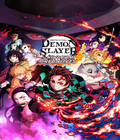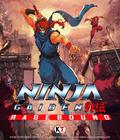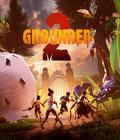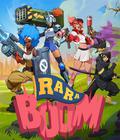Ninja Gaiden: Ragebound is a side-story set alongside the original NES Ninja Gaiden game. Players take on the role of Kenji, a ninja-in-training at the Hayabusa Ninja Village. No sooner does Ryu Hayabusa leave on his destined trip to America for the original game than the village comes under attack by malicious demons. Kenji's attempt to stop them leaves him nearly dead, with his only hope for survival a dangerous pact with a similarly wounded ninja of a rival clan, Kumori. The two fuse, with Kumori's ghostly spirit mixing with Kenji's physical form, and set out to defeat the demons and perhaps find a cure for their condition.
Ragebound is very much a modernized take of the classic Ninja Gaiden 2D platformers. As in those games, you play as a heroic blue-clad ninja of the Hayabusa clan as you slash, jump, and ninja your way through a variety of levels. The core gameplay is extremely easy to pick up; you only have a slash and jump button to start. The first level, where you play as Jo Hayabusa, plays pretty much exactly like a modernized version of the original game. It's only afterward that the game starts to gradually introduce new mechanics.
Things get more complex a few levels into the game, when Kenji meets Kumori and they fuse. From that point on, Kenji's basic ninja skills are augmented by a few tools. At any time, you can press a button, and Kumori will throw a kunai in the direction you're aiming. You also get a variety of special ninja tools that you can change between stages. These tools range from homing thrown fans to a protective umbrella shield to armor-piercing grenades. However, both the basic kunai and special attacks all drain your energy bar, which only refills by performing melee attacks with Kenji, forcing you to swap between the two naturally and plan the best use of Kumori's power.
The thing that really makes Ragebound shine is the Guillotine Boost mechanic. At any time, you can press the jump button again to do a AoE slash around your character. Should this hit an enemy, projectile or object, you'll bounce higher into the air, and it will reset your ability to execute a Guillotine Boost. This means that with proper use of the technique, you can remain in the air, constantly bouncing around from foe to foe and assuring you have a combat advantage over them. You can also use it to complete platforming segments with lengthy chained bounces over deadly pits. It's such a simple and yet immensely fun mechanic that it adds some much-deserved spice to the basic Ninja Gaiden gameplay.
One of the more interesting mechanics in the game is Hypercharge. Certain enemies in the environment are surrounded by an aura, either blue or purple. If you kill them with an attack corresponding to that character (Kenji for blue, Kumori for purple), your next attack will gain the Hypercharge status. Hitting any regular enemy with a Hypercharge attack instantly kills them, and hitting a boss with one will stun the boss and allow you to pile on damage while hypercharged. You're also able to sacrifice a portion of your health bar to charge your next move. This can be immensely useful in boss fights if you're willing to put yourself in greater danger to finish the fight faster. However, the charge only lasts a few seconds, and it is used up even if your attack doesn't hit anything, so button-mashing can ruin your day.
Hypercharge has a pretty fun impact on level design. Enemies in the game tend to be divided into those who die in one or two hits and those who are extra dangerous and take multiple hits to defeat. Generally, whenever a dangerous foe appears, there will be an aura-clad enemy nearby to defeat and then use to one-shot the beefy foe. As the game progresses, you'll start chaining together Hypercharge moves, and you're forced to alternate between Kenji and Kumori's attacks to create a lengthy string of combos, while using your Guillotine Boost to avoid wasting your charge on weak foe.
Hypercharge attacks are important because every enemy you kill also fills up your Ragebound gauge. This gauge, when full, lets you perform a special Ragebound attack using both characters. These are powerful super moves that let you do things like heal your character, freeze everything on-screen, or shoot a massive AoE screen-clearing super move. These attacks are powerful, and when used correctly, can make things a lot easier, particularly on bosses where a well-timed Ragebound attack can deplete a quarter of their health.
What makes the gameplay in Ragebound so satisfying is how everything comes together when you're in the groove. You go from moving through the stage to effortlessly bouncing, slashing, dashing and throwing your way through swarms of foes with ease. Once you get good at chaining together Hypercharge chains and Guillotine Boost bounces, you feel closer to Sonic the Hedgehog than a simple ninja, occasionally popping a Ragebound attack if things get too spicy.
If I had one complaint, it is that the Hypercharge mechanic has a slight lag to it. The period of time between you killing the enemy and getting the charge is delayed just long enough that a good chunk of the damage I took in the game was by swinging too early, assuming the charge had already triggered. It's something I could get used to, but I think it would've felt smoother if you got the Hypercharge instantly upon killing the enemy instead of needing the couple of moments. It's a minor complaint, and it was easy enough to adjust to it after a couple of levels.
The level design is strong, with most stages having a reliable and fun flow and enough interesting gimmicks to remain interesting without overstaying their welcome. Some stages might require you to sneak through saw-filled vents or hide behind solid objects while an enemy in the background shoots screen-filling laser blasts. There are a number of secrets in each stage, including special challenges you're tasked with completing (e.g., "don't fall into pits," "defeat the boss without taking damage"), special scarabs you collect to power up your character with new skills and abilities, and even hidden bonus stages.
The overall difficulty of Ragebound is probably the lowest in the franchise but not in a bad way. Your gestalt protagonists share a sizable HP bar, and you'll get a number of ways to replenish your health as the game progresses. You have infinite lives and replenish them at checkpoints, so it's possible to brute-force your way through everything. However, the game offers both a scoring system (with good scores being necessary for certain item unlocks) and a various of handicap items to boost the difficulty if you want more of a challenge. There's also an unlockable harder difficulty once you finish the game. It's still easier than the NES titles but mostly because it controls and plays so smoothly, rather than being populated by the most annoying birds to ever exist in a game.
It helps that Ragebound is gorgeous — or perhaps "gore-geous" is the better word. The hand-drawn sprite animation is phenomenal and contains a ton of wonderful details. Every enemy has multiple death animations depending on how they are killed, but every bit of the game looks fantastic from start to finish. Even the hand-drawn cut scenes that mimic the theater scenes of the original Ninja Gaiden look great. The soundtrack is also phenomenal, containing some remixes of classic Ninja Gaiden songs and some brand-new music, all of which perfectly fits the pulse-pounding excitement of the stages.
Ninja Gaiden: Ragebound is a pitch-perfect revival of the NES classics. It captures the same fun run-and-slash feel of the original games while modernizing enough to be exciting to play, whether you're a returning fan or a newcomer. The fantastic soundtrack and excellent graphics elevate it and make the entire package shine. The closest thing I can come to as a complaint is the somewhat low difficulty level, and that is more in comparison to the franchise as a whole rather than this game being too easy. If you're a fan of action-platformers or a Ninja Gaiden fan in general, you'll find a ton to love in Ragebound.
Score: 9.0/10
More articles about Ninja Gaiden: Ragebound
























